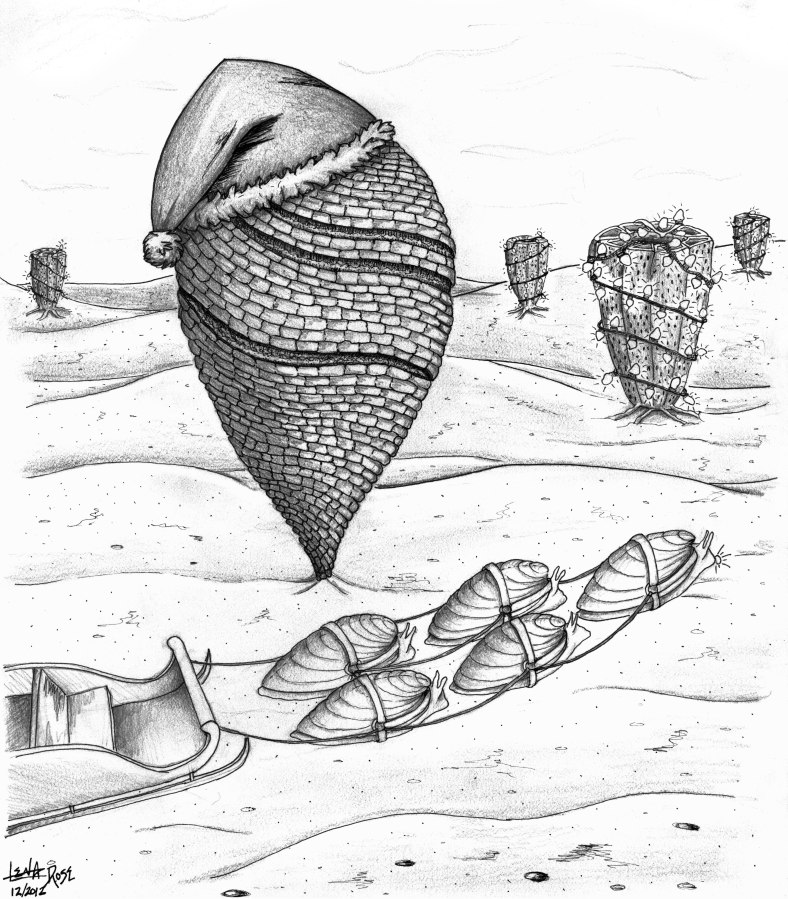A few years ago I did a slightly speculative drawing of a holiday-themed Cambrian matground community…
Starring in this drawing is a helicoplacoid cast as Santa (Helicoplacus santacus*), which is accompanied by monoplacophorans (single-shelled molluscs) as reindeer and archaeocyathids (sponges) as Christmas trees.
So what’s a helicoplacoid?
Helicoplacoids are a favorite of mine because they are echinoderms. They also look great in hats** and they are less impossible to draw that most echinoderms***. To explain helicoplacoids, I guess I should briefly explain echinoderms.
Echinoderms are a fascinating and enthralling group of marine invertebrates that are represented today by things like starfish, sea urchins, sand dollars, sea cucumbers, crinoids (feather stars), and brittle stars. There are also LOTS of cool and bizarre groups of echinoderms that are now extinct. The people who study echinoderms love them very much. Many a researcher has spent countless happy hours unraveling the mysteries of phylum Echinodermata. The take-away message about echinoderms is they are awesome.
Back to helicoplacoids…Most familiar echinoderms have five-fold symmetry (think starfish) but some of the primitive groups had very different symmetry. One such group without five-fold symmetry was the helicoplacoids, which instead have a spiral (helical – hence the name) body pattern. This was though to be a derived condition, but interestingly, a recent paper pointed out that gogiids (another group of early echinoderms) disarticulate in a spiral pattern after dying, indicating they may share the same spiral body pattern as helicoplacoids.
And what’s a matground?
Matgrounds were characteristic substrates in the Neoproterozoic and early Cambrian. They were formed by microbial mats that covered the surface of the ocean floor. Even though matgrounds were made of tasty bacteria and archaea, most sea creatures interested in eating microbes just grazed on the surface of the matgrounds. The substrate was stabilized by the microbial mats, and all was well.
Then something called the “Cambrian substrate revolution” occurred. Burrowing animals appeared and began tunneling through the upper layers of the substrate, which disrupted the matgrounds, mixed the sediment, and softened the substrate. These softer substrates are more characteristic of Paleozoic environments.
What happened to the helicoplacoids?
Matground substrates were very important to helicoplacoids, because they were adapted to stick the lower portion of the body into the substrate, leaving the upper part with the feeding grooves, called ambulacra, exposed (not like I showed in the drawing above where the whole thing is sticking out, which is probably wrong). When soft substrates took over after the Cambrian substrate revolution, the little helicoplacoids had no way to position themselves properly and thus would have sunk in to the sediment. And so, like more than 99% of everything that has ever lived, they went extinct.
Merry Christmas & Happy Holidays!
*Not an actual scientific name.
**Little known fact: most echinoderms look great in hats.
***Echinoderm skeletons are made of anywhere from tens to thousands of individual plates. It’s really freaking hard to draw all those plates.
More about helicoplacoids and the Cambrian substrate revolution:
Bottjer, D.J., J.W. Hagadorn, and S.Q. Dornbos. 2000. The Cambrian substrate revolution. GSA today 10: 1-7.
Dornbos, S.Q., and D.J. Bottjer. 2000. Evolutionary paleoecology of the earliest echinoderms: Helicoplacoids and the Cambrian substrate revolution. Geology 28: 839-842.
